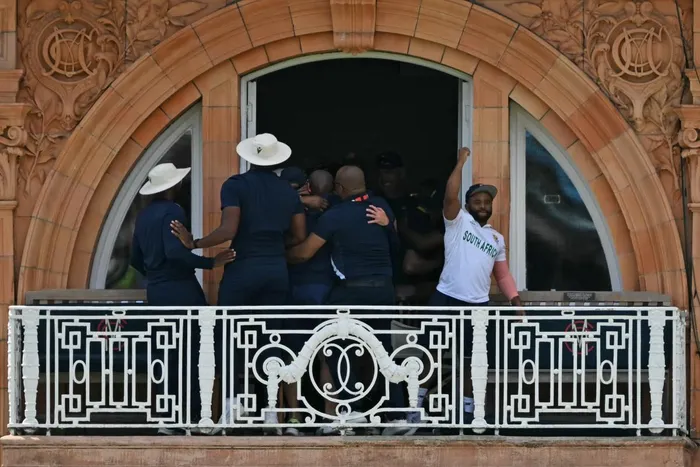The tale of two Tests: Why it's time for a two-tier system in cricket
Sharp Turn

The Proteas, captained by Temba Bavuma, recently won the World Test Championship at Lord's after beating Australia in the final. Photo: AFP
Image: AFP
COMMENT
In the one corner, there was Lord’s.
Splendid in all its regality. A full house on the fifth day enjoying a spectacle rivalled only by events at the very same ground just a few weeks earlier, when the Proteas lifted the Test mace in spectacular fashion.
All three results were still possible, with both England and India teetering on the edge. The tension was palpable — sledging, swearing, and high-stakes cricket captivating a global audience.
Over 7 500km away, in far-off Jamaica, two other teams were slogging through the motions at a near-deserted Sabina Park.
Not too long ago, the Frank Worrell Trophy — contested by the West Indies and Australia — was one of the most sought-after titles in world cricket. Thousands would cram into the George Headley Stand, with the picturesque Blue Mountains providing the idyllic Caribbean backdrop.
But in 2025, the eminence of both the FWT — dominated by Australia for over two decades — and the West Indies themselves has dimmed alarmingly.
Yet, not even the Windies’ most disillusioned critic could have foreseen the looming nadir of this once-proud cricketing nation.
The absolute carnage that unfolded in 14.3 overs of mayhem was painful to watch. The West Indies slumped to 11 for 6 in just 5.2 overs, before collapsing entirely for a pitiful 27 all out.
Not since 1955 has a lower score been recorded in the history of Test cricket.
The embarrassment was compounded by the occasion: the 50th anniversary of the West Indies’ triumph in the inaugural Cricket World Cup — a tournament won by legends such as Sir Viv Richards, Sir Clive Lloyd, Michael Holding, and Andy Roberts.
That very generation watched, helplessly, as the current crop — masquerading as Test cricketers — capitulated.
Former captain Carl Hooper echoed the anger of a region, describing himself as “angry” and “upset”. He went further: “It’s not as if you can see some light at the end of the tunnel.”
Which brings me to my point — one echoed recently by Ravi Shastri — that Test cricket must implement a two-tier system.
Test cricket simply cannot afford to carry nations like the West Indies any longer. As heartbreaking as it may be for the likes of Lloyd to witness his beloved team demoted, there is no other viable path forward.
The same logic applies to Zimbabwe. The Proteas’ recent demolition of their northern neighbours across two Tests did little to enhance the prestige or appeal of the longest format.
Wiaan Mulder’s refusal to pursue a world-record individual score — choosing instead to let a “legend” keep the title — speaks volumes. Had his unbeaten 367 come against one of the so-called "Big Three", there’s little doubt he would have pushed for history.
In today’s cricket landscape, where the calendar is hopelessly congested, there simply isn't room for one-sided Test series that sap the sport’s energy and public interest.
Recent series between evenly matched sides — South Africa v India, England v Australia, Pakistan v New Zealand — have delivered riveting cricket, packed stadiums, and huge digital engagement. That is the standard fans crave.
Difficult decisions need to be made — and soon. Test cricket remains the sport’s purest form, its absolute pinnacle.
But to preserve it, the game must prioritise quality over sentiment. The best teams must play each other regularly, free from the drag of nostalgia and the dead weight of decayed dynasties.
Related Topics: